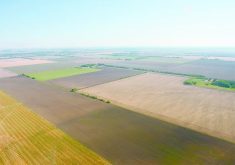Research based on 9,506 species and 200 fossils provides a deeper understanding of planet’s most diverse plant group
WASHINGTON, D.C. (Reuters) — Flowering plants ranging from corn, wheat and potatoes to maple, oak, apple and cherry trees, roses, tulips, daisies and dandelions are cornerstones of Earth’s ecosystems and essential for humankind.
New research based on genome data for 9,506 species, as well as an examination of 200 fossils, provides the deepest understanding to date of the evolutionary history of flowering plants, called angiosperms, which are the largest and most diverse plant group.
It details how angiosperms appeared and became dominant during the age of dinosaurs and how they have changed over time.
Read Also

Sustainable food has ‘lost all meaning’: prof
That marketing strategy is deader than a doornail, says a University of Guelph professor who specializes in consumer preferences and perceptions of agriculture and food.
The scientists devised a new tree of life for angiosperms, covering 15 times more types of flowering plants — nearly 60 per cent of them — than the nearest comparable study.
“It is a massive leap forward in our understanding of plant evolution,” said botanist William Baker of the Royal Botanic Gardens Kew in London, senior author of the research published April 24 in the journal Nature.
Angiosperms, plants that produce flowers and generate their seeds in fruits, encompass about 330,000 species and comprise about 80 per cent of the world’s plants.
They include, among others, all the major food crops, grasses, most broad-leaved trees and most aquatic plants. Their closest relatives are the gymnosperms, a group that preceded them on Earth and includes conifers and some others, with a bit more than 1,000 species.
The study identified two pulses of diversification among angiosperms. The first one occurred around 150-140 million years ago at the dawn of their existence during the Mesozoic era, with 80 per cent of major angiosperm lineages arising during that time.
The next one happened about 100 million years later, during the Cenozoic era, after the demise of dinosaurs and the rise of mammals, amid decreasing global temperatures.
“Angiosperms have many structural adaptations that confer advantages over gymnosperms, but chief among these are those contributing to reproductive success,” Baker said.
Gymnosperms and angiosperms both have seeds, but the flowering plants have enclosed seeds that protect them from dehydration and enable them to prosper in a wider range of environments, from tropics to deserts to Antarctica.
They also evolved the flower, a structure that allowed them to form relationships with animal pollinators, especially insects. Gymnosperms usually rely upon the wind for pollination. Angiosperms evolved a high diversity of fruit types, permitting effective seed dispersal.
“With these innovations, angiosperms have become invincible,” Baker said.
Charles Darwin, the 19th century British naturalist and architect of evolutionary theory, was astonished by how flowering plants exploded onto the scene in the Mesozoic fossil record.
In an 1879 letter to Joseph Hooker, RBG Kew’s then-director, Darwin wrote that “the rapid development as far as we can judge of all the higher plants within recent geological times is an abominable mystery.”
“Remarkably,” Baker said, “we have been able to use the ‘molecular fossil record,’ the accumulated change in DNA over time, to see real evidence of that explosion happening at the dawn of the angiosperms.”
Flowering plants provide the majority of calories consumed by humans — grains, fruits and vegetables — and feed for livestock. They also have enthralled people with their beauty and fragrance.
“They are sources of many of our medicines and hold potential solutions to global challenges, such as climate change, biodiversity loss, human health, food security and renewable energy,” Baker said.
The study could help scientists better understand disease and pest resistance in angiosperms and navigate potential new medicinal uses.
“Combining the tree of life with extinction risk assessments for each lineage allow us to prioritize lineages for conservation based on their uniqueness,” said Kew botanist and study lead author Alexandre Zuntini.
“This is extremely important for mankind, as these lineages may hold chemical compounds or even genes that can be useful for survival of our species.”

















